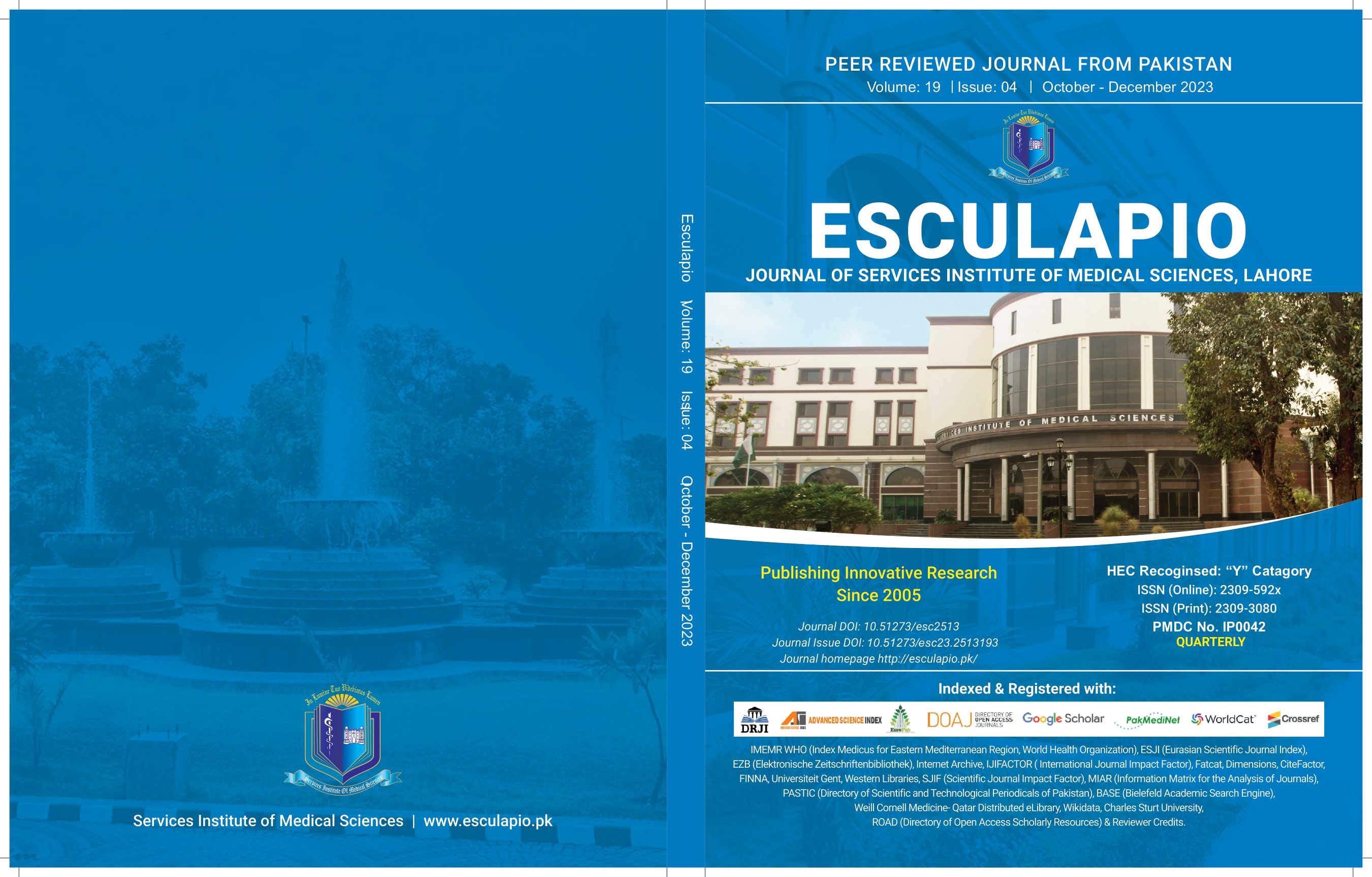Comparison of Antibiotic Coated Vicryl Vs Non-Coated Vicryl in Abdominal Fascial Closure After Laparotomy in Children
DOI:
https://doi.org/10.51273/esc23.25131942Keywords:
Triclosan coated vicryl, , Vicryl plus, , surgical site infection, uncoated vicrylAbstract
Objective: To compare the outcome of antibiotic-coated vicryl versus non-coated vicryl in abdominal fascial closure after laparotomy in children regarding surgical site infections in contaminated wounds.
Material and Method: This randomized control study (NCT06129773) was conducted for one year at The Children's Hospital and University of Child Health Sciences, Lahore. According to the operational criteria, 100 patients were included in the research and randomly divided into two groups (50 patients in each Group). All patients were assessed for surgical site infection on the 3rd, 7th, and 30th postoperative days using the Southampton wound grading system. The student's t-test and Chi-square tests were applied in SPSS version 24 to interpret the associations between different variables. A P-value of <0.05 was considered significant.
Results: Both groups have similar demographic parameters like age and weight distribution. The mean age of the children in abdominal fascial closure with antibiotic-coated vicryl was 64.09±50.14 months, while in non-coated vicryl was 64.26± 53.45 months (p-value of 0.164). There was a male predominance in the study population, with 70 % males and 30 % females. The total surgical site infection (SSI) incidence following laparotomy was 37%. Surgical site infections occurred in 22% of patients in abdominal fascial closure with antibiotic-coated vicryl and 52% in the non-coated vicryl Group (p-value: 0.002). The hospital stay in the antibiotic-coated vicryl Group was significantly shorter than non-coated group. (4.20 versus 8.24 days. P- value: 0.001).
Conclusions: The results of our study concluded that antibiotic-coated vicryl is superior to uncoated vicryl
for abdominal fascial closure after laparotomy in contaminated wounds in children
References
Ceresoli M, Carissimi F, Piemontese A, Parago V, Galvain T, Tommaselli GA, Gianotti L. The Clinical and Economic Value of Triclosan-Coated Surgical Sutures in Abdominal Surgery. Applied Sciences. 2020 Feb 6;10(3):1090.
Farid‐Mojtahedi M, Sepidarkish M, Almukhtar M, Eslami Y, Mohammadianamiri F, Moghadam KB, Rouholamin S, Razavi M, Jafari M, Fazlollahpour-Naghibi A, Rostami Z. Global Incidence of Surgical Site Infection Following Caesarean Section: A Systematic Review and Meta-analysis. Journal of Hospital Infection. 2023 Jun 10.
Mahaseth BK. Abdominal Wound Closure In Gynaecological Or Obstetrical Surgery With Vicryl®(Polyglactin910) Versus Vicryl Plus®(Polyglactin910 With Triclosan Added): A Comparative Study. Journal of Nepalgunj Medical College. 2019 Aug 22;17(1):10-2.
De Simone B, Sartelli M, Coccolini F, Ball CG, Brambillasca P, Chiarugi M, Campanile FC, Nita G, Corbella D, Leppaniemi A, Boschini E. Intraoperative surgical site infection control and prevention: a position paper and future addendum to WSES intra-abdominal infections guidelines. World journal of emergency surgery. 2020 Dec;15(1):1-23.
Dragovic M, Pejovic M, Stepic J, Colic S, Dozic B, Dragovic S, Lazarevic M, Nikolic N, Milasin J, Milicic B. Comparison of four different suture materials in respect to oral wound healing, microbial colonization, tissue reaction and clinical features—randomized clinical study. Clinical oral investigations. 2020 Apr;24:1527-41.
Gorgun E, Rencuzogullari A, Ozben V, Stocchi L, Fraser T, Benlice C, Hull T. An effective bundled approach reduces surgical site infections in a high-outlier colorectal unit. Diseases of the Colon & Rectum. 2018 Jan 1;61(1):89-98.
Vinu MJ. Impact of using Antibacterial Suture Vicryl Plus Versus Catgut on Oral Surgical Site: A Comparative study (Doctoral dissertation, Best Dental Science College, Madurai).
Otterness K, Singer AJ. Updates in emergency department laceration management. Clinical and Experimental Emergency Medicine. 2019 Jun;6(2):97.
Obermeier A, Schneider J, Harrasser N, Tübel J, Mühlhofer H, Pförringer D, Deimling CV, Foehr P, Kiefel B, Krämer C, Stemberger A. Viable adhered Staphylococcus aureus highly reduced on novel antimicrobial sutures using chlorhexidine and octenidine to avoid surgical site infection (SSI). PloS one. 2018 Jan 9;13(1):e0190912.
Luitel BR, Kandel SP, Shrestha B, Sapkota R, Bhandari RS. Prediction of surgical site infection and other adverse postoperative outcomes. Journal of Institute of Medicine. 2010 Jan 7;32(1).
Shah S, Singhal T, Naik R. A 4-year prospective study to determine the incidence and microbial etiology of surgical site infections at a private tertiary care hospital in Mumbai, India. American journal of infection control. 2015 Jan 1;43(1):59-62.
Arslan NC, Atasoy G, Altintas T, Terzi C. Effect of triclosan-coated sutures on surgical site infections in pilonidal disease: prospective randomized study. International journal of colorectal disease. 2018 Oct;33:1445-52.
Rašić Ž, Schwarz D, Nesek Adam V, Sever M, Lojo N, Rašić D, Matejić T. Efficacy of antimicrobial triclosan-coated polyglactin 910 (Vicryl* Plus) suture for closure of the abdominal wall after colorectal surgery. Collegium antropologicum. 2011 Jun 24;35(2):439-43.
Baracs J, Huszár O, Sajjadi SG, Horváth ÖP. Surgical site infections after abdominal closure in colorectal surgery using triclosan-coated absorbable suture (PDS Plus) vs. uncoated sutures (PDS II): a randomized multicenter study. Surgical infections. 2011 Dec 1;12(6):483-9.
Nakamura T, Kashimura N, Noji T, Suzuki O, Ambo Y, Nakamura F, Kishida A. Triclosan-coated sutures reduce the incidence of wound infections and the costs after colorectal surgery: a randomized controlled trial. Surgery. 2013 Apr 1;153(4):576-83.










